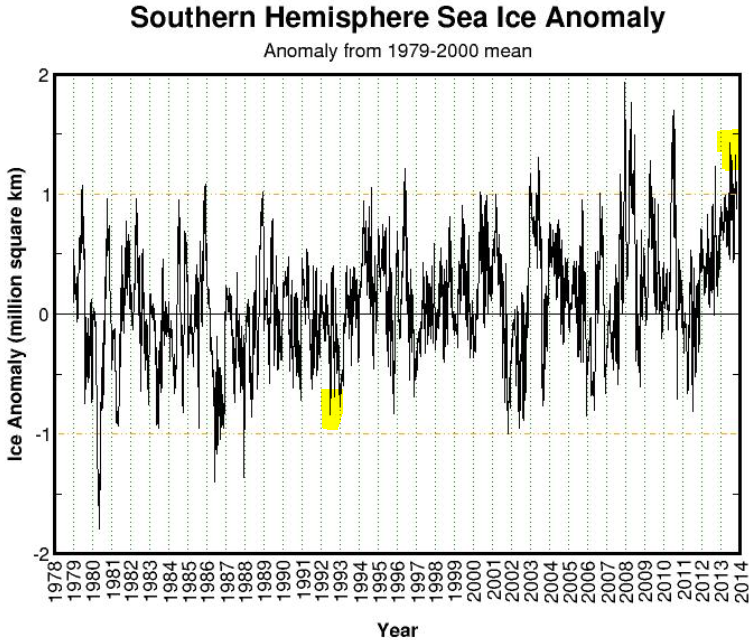Polar scientist Dr. Peter Lemke of Germany’s renowned Alfred Wegener Institute was interviewed here about climate change, its affect on the Earth’s polar regions and about his recent winter expedition to Antarctica.
In the Arctic part of the interview, Lemke repeats the usual man-is-melting-the-Arctic narrative that you often hear from many state-funded alarmist climate scientists. No surprise here.
But as always, when it comes to sea ice, eventually warmist polar scientists get tripped up by Antarctica. And sure enough, Lemke trips and stumbles when Antarctic sea ice gets brought up. Before too long he is forced to concede he is stumped and has to admit that sea ice at the South Pole has grown and that he has no real explanation.
Peter Lemke has been on several expeditions to Antarctica: in 1989, 1992, 2006, and now 2013. And each time they collected data. Today, after comparing the preliminary results of the 2013 to those of 1992, here’s what Lemke says:
“…from our early results, it looks like that the sea ice mass around Antarctica has increased slightly. Our measurements showed that the sea ice was more extensive, thicker and more densely packed as compared to our 1992 expedition, which was on the same track during the same season.”
Increased slightly? In the following chart I’ve highlighted the winter of the years 1992 and 2013 to show what Lemke means by “increased slightly“:
Chart source: arctic.atmos.uiuc.edu/cryosphere/jpg
It’s obvious that Lemke is attempting to seriously downplay the Antarctic sea ice growth that has occurred since 1992. Indeed the above chart shows that sea ice has grown by more than 1.5 million square kilometers. That’s not increasing “slightly”. We suppose that if the trend had been the other way around, we’d be hearing terms like considerable reduction or even possibly dramatic reduction.
What’s more, Lemke also confirms that this extra 1.5 million square kilometers is “thicker” and “more compact”, meaning there’s much more ice mass.
So why is the ice growing? This goes against all the claims of global warming. Here, typical of warmist scientists who are confronted with inconvenient data, Lemke acts like he has the answer…before admitting he really has no clue (my emphasis):
One explanation is that in the Southern Hemisphere the westerly winds are increasing, and through friction this drives the ice towards lower latitudes and the extent is getting a bit bigger. When the ice expands there is open water between ice floes, and it’s still cold enough in winter that ice freezes in the open patches.
There are other physical processes that may be involved, such as the heavy snow cover that blankets the Antarctic sea ice. Sometimes the heavy snow load submerges the ice floe underwater so that the interface of ice and snow is actually below sea level, and seawater drains into the snow and freezes. That may be one process, but there are others that are not really resolved yet.
We don’t yet have the answers to these questions, because there are very few measurements and you cannot deduce snow from satellite remote sensing data, yet. To find out, you have to go there and make measurements yourself. But winter expeditions are very rare. There are very few icebreakers that can actually go into the Antarctic winter into the sea ice.”
The science is settled, except for the majority that isn’t.
Never trust a climate scientist who acts like he’s sure. It’s a dead give away that he hasn’t got a clue about what’s really going on.






[…] Renowned Warmist Scientist Peter Lemke: Antarctic Sea Ice ‘More Extensive, Thicker, And More Dense… […]
“So round, so firm, so fully packed so easy on the draw.”
The advertising line seems to apply equally well in describing
the Antarctic snow pack in 2013 as it did for Lucky Strike
cigaretts marketed by the American Tobacco Company in the 1940s.
“LSMFT.” But don’t get the wrong idea. I don’t even smoke.
HL
[…] […]
It was the wind that did it. I used to blame the dog for the wind problems, but lets go to the quote from above:
“One explanation is that in the Southern Hemisphere the westerly winds are increasing, and through friction this drives the ice towards lower latitudes and the extent is getting a bit bigger.”
But, wind is what causes Trenberth’s ‘missing heat’ to go down deep, according to Gavin@realclimate. “The First Law of Thermodynamics sends greetings,” guffaws Gavin.
http://www.realclimate.org/index.php/archives/2013/09/what-ocean-heating-reveals-about-global-warming/
But, way back in 2006, realclimate & Raymond Pierrehumbert had a different explanation response to comment#7:
“This argument shows that a permanent El Nino would have a different effect on global temperature than a transient one, since all that newly exposed warm water would eventually cool off. The subsurface water, by the way, is colder than the surface water.”
http://www.realclimate.org/index.php/archives/2006/05/el-nino-global-warming/
Not according to Gavin, settled science, circa 2013.
The First Law of Thermodynamics sends greetings.
(Obviously 2 different oceans, but how does slanted wind only deliver four Hiroshima bombs of energy a minute to one ocean?)
“The two polar regions are essentially geographic opposites,” said Sharon Stammerjohn, a sea ice expert at the University of Colorado Institute for Arctic and Alpine Research (INSTAAR). “Sea ice in the Arctic Ocean is land-locked, while sea ice in the Southern Ocean is surrounded by open ocean.” That means that while Arctic sea ice is confined in a given space, Antarctic sea ice can spread out across the ocean, pushed by winds and waves. That also means that ice extent varies much more in the Southern Hemisphere than it does in the North.
That doesn’t really explain why rising CO2 makes minimum extents in NH shrink and in SH grow. (Assuming just for fun that CO2 plays a role; which is the funny theory of the warmist.)